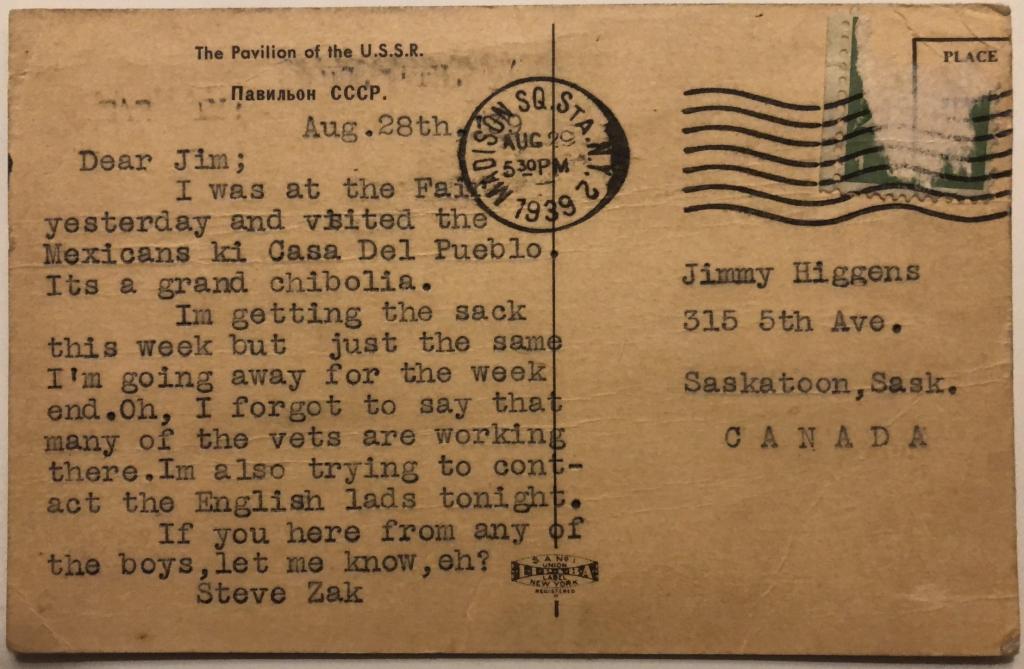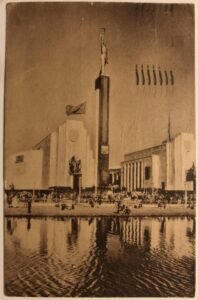A Mac-Pap Amongst the Lincolns
On returning to Canada from the Spanish Civil War, Jim Higgins was branded a communist, hounded by the RCMP, and welcomed by his Lincoln Battalion comrades when he sought refuge in New York. In his soon-to-be-published book, he writes, “It rained like hell but I was very happy.”
It was while he was in New York that Jim met a Greenwich Village artist who wanted to know more about him, and over the course of many weeks, in response to the artist’s probing questions, he related his story. It must have been a trusting relationship because Jim was otherwise prone to secrecy.
Then, in early 1977, Jim’s children, who knew little about him before he met their mother, convinced him to write about his mysterious past. He agreed, but had crumpled many a false start until he remembered that artist decades ago in New York, in turn opening the floodgates to the details of his story. He wrote all that year.
As Jim’s eldest daughter, I have been editing and preparing his manuscript, part of which, it turns out, was written in 1939 when he returned from the Spanish Civil War. His book, Fighting for Democracy, will be published in June 2020.
The artist’s name is lost to time but there are several Americans with Spanish Civil War connections whose names are not. Captain Rafael Buch Brage is mentioned in Jim’s chapter about the Aragon Retreats of March 1938. Brage was observing through field glasses from company headquarters when he saw Jim lugging ammo and a machine gun out to a strategic spot, while dodging hundreds of bullets in no man’s land.
Jim stumbled twice and both times Brage thought he’d been hit. So, apparently, did the enemy, and when he reached cover, Jim took full advantage of the opportunity. His detailed description of this heart-pounding action makes for a riveting read.
Interestingly, Jim didn’t seem to remember any bravery citation when he wrote his memoir but his RGASPI personnel file contains a report from Helge Meyer, political commissar of the Mac-Paps, stating that he was “extraordinarily brave during the big retreats.”
I knew about Lincoln veteran Steve Zak because, amongst Jim’s papers, is a postcard from him dated August 1939. At that time, Jim was based in Saskatoon, having spent five months distributing aid to Mac-Pap vets across Canada’s three Prairie Provinces: Alberta, Saskatchewan, and Manitoba.
Zak’s postcard, featuring the USSR pavilion from the New York World’s Fair, reads:
I was at the Fair yesterday and visited the Mexicans ki Casa Del Pueblo. Its (sic) a grand chibolia. I’m getting the sack this week but just the same I’m going away for the weekend. Oh, I forgot to say that many of the vets are working there. I’m also trying to contact the English lads tonight. If you here (sic) from any of the boys, let me know, eh? Steve Zak
Steve Zak’s bio on the ALBA website, indicates how they knew each other: Zak was with the Mac-Paps for a while, and they both served in the Machine-Gun Battalion attached to the 15th Brigade.
Other Lincolns are mentioned in passing: “Jack Matthews,” a driver attached to brigade headquarters, got the fright of his life when Jim jumped onto the road with his finger on the trigger of his sidearm. Jim and another comrade had been lagging behind with their machine gun as the enemy was closing in and “Jack” had been sent to pick them up. Jack’s real name was probably Kopel Koplowitz who, according to his ALBA bio, was an “auto park intendente” with the 15th Brigade.
Around the time of receiving Zak’s postcard, Jim was working on a Saskatoon by-election campaign in which all parties on the left agreed to cooperate, including the Social Credit, the Cooperative Commonwealth Federation and the Canadian Communist Party. They called themselves the United Reform Movement and went on to contest a long-held Liberal seat. The candidate, W. G. Brown, was a Presbyterian Minister, active in social justice causes.
W.G. Brown himself was the driving force but, as a member of the campaign executive committee (only known because it’s in his RCMP file), Jim did his part to foster cooperation amongst these disparate groups. In doing so, he was passing on a valuable lesson he’d learned in Spain about the importance of a united left.
He told the first meeting of the group representing the different organizations, “Franco, Hitler, Mussolini, and the church were so united at the outset that they got the jump on the divided forces trying to defend the elected Spanish government. We must set aside our differences …and always keep in mind the reason we are here tonight is to unite forces to get our candidate elected.” W. G. Brown did, indeed, win. It’s an inspirational example for today.
A year after that historic by-election, Jim was in New York living on the Lower East Side. It was the winter of 1940-41. Why? As a child, I knew he’d spent time in New York before he met my mother, but I’d wondered why he went. I thought it was for the adventure. It’s only recently that I’ve learned the real reason.
It turns out that Jim’s high profile in Saskatoon brought him to the attention of the mayor, the city’s newspaper and, not surprisingly, the Royal Canadian Mounted Police (RCMP), Canada’s equivalent to the Federal Bureau of Investigation (FBI). Both organizations reflected their governments’ obsession with real and suspected “Reds” or “commies,” i.e. anyone with leftist political views and certainly anyone who had volunteered for Spain.
A few months after the 1939 by-election, Jim headed to British Columbia where he bought a bike and crossed the border illegally, planning to cycle to New York; along the way, visiting families of his fallen American comrades.
He was no doubt grateful to be free from harassment—his RCMP file, received under an Access to Information request, contains nineteen reports from the time he returned to Saskatoon from Spain in February 1939 until he left in the Spring of 1940.
His file also includes a search warrant executed at his last known address. He may or may not have fled by then: Thanks to a friend who was superintendent of an apartment building, he spent part of early 1940 (hiding out?) in the building’s boiler room—that is, until the owner found out.
That New York winter of 1940-41, Jim got a job picketing furriers and, though he didn’t write about his girlfriend, other than to say she worked in one of the sweatshops, I remember him telling me that he once had a Jewish girlfriend in New York named “Lilly.”
Then, when I was organizing his papers in 2017, I came across a book of drawings by Luis Quintanilla with a preface by Ernest Hemingway. Like most of his papers, I’d never seen it before. Inside, it was inscribed:
To one who has endured much of what is in this book. I and many millions are trying to change it though. Through our defeats we’ll rise victorious. Long live the Spanish people and the Loyalist gov’t. A comrade, Lillyan
In 2019, when I finally received his RCMP file, though it had been purged in the 1970s and redacted before being sent to me, it contained two letters from Lillyan. They weren’t originals—they had been intercepted and typed, presumably before continuing on their way to Jim.
That means I now know Lilly’s full name and where she was living. Though my father reveals much in the book, and though I’ve dug up other secrets, Lilly will remain anonymous. Some things are meant to be.
Fighting for Democracy: The True Story of Jim Higgins (1907-1982), A Canadian Activist in Spain’s Civil War by Jim Higgins with Janette Higgins, will be published in Fall 2020. More information at www.janettehiggins.com.















I posted the link to this piece on my blog, and someone there wrote the following:
Looking forward to the book! In the postcard I note his friend refers to the “Mexicanski” pavilion, not simply Mexican. I wonder if this is because of the fact that a number of rifles that went to the International Brigades were Russian Moisin-Nagants supplied via Mexico. Brigaders were apparently told to keep the Russian origin secret, and referred to them as Mexicanski. And now reflecting on the fact that the postcard is in fact from the Russian pavilion, I wonder if thats what he meant all along—Mexicanski meaning Russian.
I found this to be an interesting observation and thought others would too.
Always looking for new information on your project, Janette. Thanks for posting. Hope all is progressing as it should. Hope you are staying well in these crazy times.
Sue
[…] thrilled to have a feature article, A Mac-Pap Amongst the Lincolns, published in The Volunteer, the magazine of the Abraham Lincoln Brigade in New York, Click on it, […]